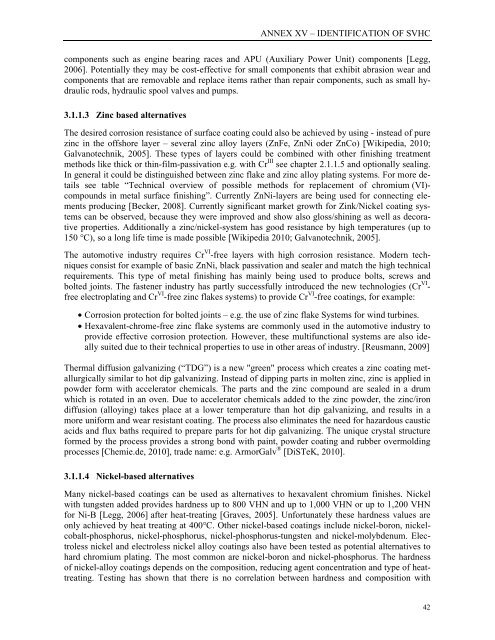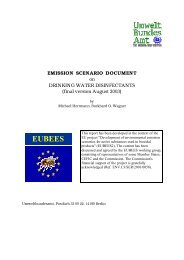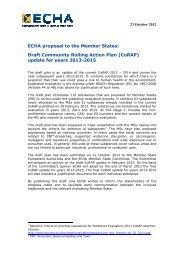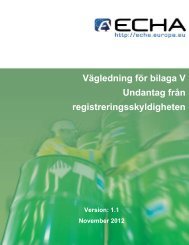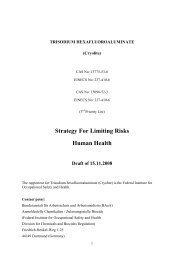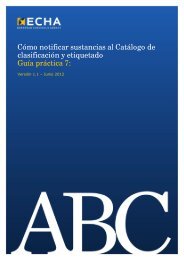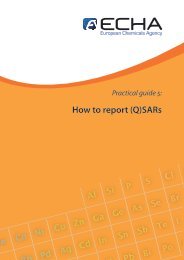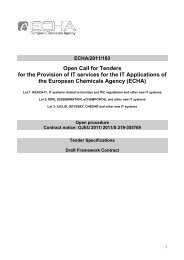Annex XV report PROPOSAL FOR IDENTIFICATION OF A ... - ECHA
Annex XV report PROPOSAL FOR IDENTIFICATION OF A ... - ECHA
Annex XV report PROPOSAL FOR IDENTIFICATION OF A ... - ECHA
You also want an ePaper? Increase the reach of your titles
YUMPU automatically turns print PDFs into web optimized ePapers that Google loves.
ANNEX <strong>XV</strong> – <strong>IDENTIFICATION</strong> <strong>OF</strong> SVHC<br />
components such as engine bearing races and APU (Auxiliary Power Unit) components [Legg,<br />
2006]. Potentially they may be cost-effective for small components that exhibit abrasion wear and<br />
components that are removable and replace items rather than repair components, such as small hydraulic<br />
rods, hydraulic spool valves and pumps.<br />
3.1.1.3 Zinc based alternatives<br />
The desired corrosion resistance of surface coating could also be achieved by using - instead of pure<br />
zinc in the offshore layer – several zinc alloy layers (ZnFe, ZnNi oder ZnCo) [Wikipedia, 2010;<br />
Galvanotechnik, 2005]. These types of layers could be combined with other finishing treatment<br />
methods like thick or thin-film-passivation e.g. with Cr III see chapter 2.1.1.5 and optionally sealing.<br />
In general it could be distinguished between zinc flake and zinc alloy plating systems. For more details<br />
see table “Technical overview of possible methods for replacement of chromium (VI)-<br />
compounds in metal surface finishing”. Currently ZnNi-layers are being used for connecting elements<br />
producing [Becker, 2008]. Currently significant market growth for Zink/Nickel coating systems<br />
can be observed, because they were improved and show also gloss/shining as well as decorative<br />
properties. Additionally a zinc/nickel-system has good resistance by high temperatures (up to<br />
150 °C), so a long life time is made possible [Wikipedia 2010; Galvanotechnik, 2005].<br />
The automotive industry requires Cr VI -free layers with high corrosion resistance. Modern techniques<br />
consist for example of basic ZnNi, black passivation and sealer and match the high technical<br />
requirements. This type of metal finishing has mainly being used to produce bolts, screws and<br />
bolted joints. The fastener industry has partly successfully introduced the new technologies (Cr VI -<br />
free electroplating and Cr VI -free zinc flakes systems) to provide Cr VI -free coatings, for example:<br />
• Corrosion protection for bolted joints – e.g. the use of zinc flake Systems for wind turbines.<br />
• Hexavalent-chrome-free zinc flake systems are commonly used in the automotive industry to<br />
provide effective corrosion protection. However, these multifunctional systems are also ideally<br />
suited due to their technical properties to use in other areas of industry. [Reusmann, 2009]<br />
Thermal diffusion galvanizing (“TDG”) is a new "green" process which creates a zinc coating metallurgically<br />
similar to hot dip galvanizing. Instead of dipping parts in molten zinc, zinc is applied in<br />
powder form with accelerator chemicals. The parts and the zinc compound are sealed in a drum<br />
which is rotated in an oven. Due to accelerator chemicals added to the zinc powder, the zinc/iron<br />
diffusion (alloying) takes place at a lower temperature than hot dip galvanizing, and results in a<br />
more uniform and wear resistant coating. The process also eliminates the need for hazardous caustic<br />
acids and flux baths required to prepare parts for hot dip galvanizing. The unique crystal structure<br />
formed by the process provides a strong bond with paint, powder coating and rubber overmolding<br />
processes [Chemie.de, 2010], trade name: e.g. ArmorGalv ® [DiSTeK, 2010].<br />
3.1.1.4 Nickel-based alternatives<br />
Many nickel-based coatings can be used as alternatives to hexavalent chromium finishes. Nickel<br />
with tungsten added provides hardness up to 800 VHN and up to 1,000 VHN or up to 1,200 VHN<br />
for Ni-B [Legg, 2006] after heat-treating [Graves, 2005]. Unfortunately these hardness values are<br />
only achieved by heat treating at 400°C. Other nickel-based coatings include nickel-boron, nickelcobalt-phosphorus,<br />
nickel-phosphorus, nickel-phosphorus-tungsten and nickel-molybdenum. Electroless<br />
nickel and electroless nickel alloy coatings also have been tested as potential alternatives to<br />
hard chromium plating. The most common are nickel-boron and nickel-phosphorus. The hardness<br />
of nickel-alloy coatings depends on the composition, reducing agent concentration and type of heattreating.<br />
Testing has shown that there is no correlation between hardness and composition with<br />
42


